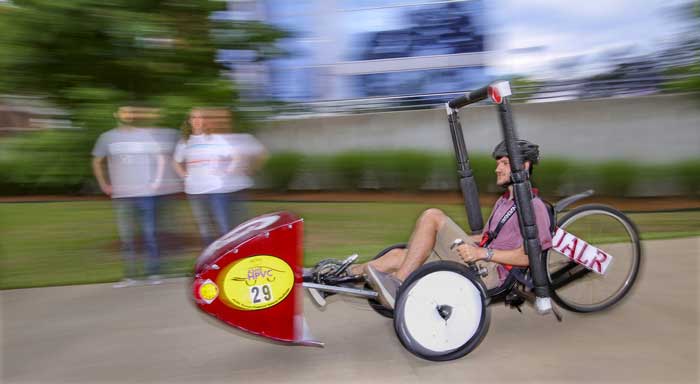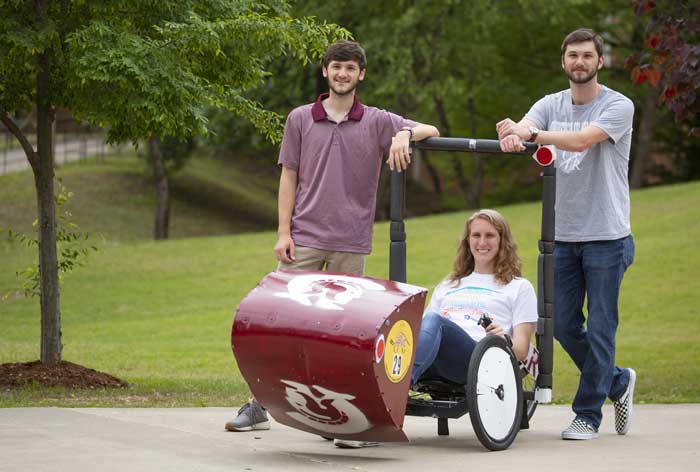UA Little Rock students compete in university’s first human powered vehicle challenge
A team of systems engineering students at the University of Arkansas at Little Rock has gone where no UA Little Rock students have gone before by participating in the Human Powered Vehicle Challenge.
For their senior design and capstone project, Team Captain Hugh Benfer, Nathanael Menhinick, Cameron Palmer, Jason Reed, and Shelby Wingate designed and built the university’s first human powered vehicle. Dr. Jin Lee, professor of systems engineering, and Dr. Samer Yahya, visiting scholar of systems engineering, served as the team’s faculty advisors.
Human-powered transport is often the only type of transportation available in underdeveloped parts of the world and is an increasingly viable form of sustainable transportation that is becoming more popular in urban areas. The challenge provides an opportunity for students to demonstrate sound engineering design principles in the development of sustainable transportation alternatives.
“A human-powered vehicle is generally for commuting in a metropolitan area,” said Benfer. “You find a way to have a more ecologically, environmentally, and economically way to commute in cities, which are filled with cars that pollute the air and take up much needed space. Human powered vehicles solve an old problem of metropolitan cities that have too many cars, crowded traffic, and little parking. As biking becomes more popular, human-powered vehicles will become more popular as people branch out and customize their experiences.”
The team worked on the human-powered vehicle, which they dubbed the “Trojan Horsepower,” during the 2017-18 academic year. Riders sit in the three-wheeled vehicle in a recumbent-bike position.
“Our human-powered vehicle is pure engineering might, steel, and zip ties. It has an extremely robust steel roll bar, so that in the event of a crash, the roll bar protects the rider and the rider will not touch the ground,” Benfer said. “We also used aerodynamic fairing, which is something that will block the wind and allows the air to move more smoothly around your body. It makes the vehicle easier to pedal. You can cut through the wind like a knife.”
The students had the opportunity to test their vehicle in the American Society of Mechanical Engineers’ Human Powered Vehicle Challenge at Pennsylvania State University April 13-15.

The Department of Systems Engineering even recognized the contributions of the students’ parents. Darin Reed, father of Jason Reed, received a special award, “Outstanding Father of the Year,” at the Donaghey College of Engineering and Information Technology’s 2018 awards ceremony for driving the team the 16-hour trek from Little Rock to Pennsylvania and back so they could participate in the competition.
The event consisted of safety tests to ensure the vehicle’s sound design, a drag race, and an endurance race in which teams competed to complete the most laps possible during a 2.5 hour race. Wingate placed 13th in the women’s drag race, while Benfer placed 18th in the men’s drag race. In the endurance race, Benfer, Palmer, Reed, and Wingate placed 13th after completing 26 total laps.
“There are obstacles like stop signs, speed bumps, and tight turns,” Benfer said. “It puts your vehicle to the test. The rumble strip is going to destroy your vehicle if anything is loose. That is what happened to us. We had to go to the pit to keep our vehicle together. It’s basically the ultimate stress test for the vehicles, and some vehicles were destroyed because the design was not robust enough. The disk brake snapped in the middle, so we had to do an emergency repair and come up with an engineering solution, which was to take the brake off and race with one brake for most of the race. Our legs were like jelly afterwards.”
UA Little Rock placed 16th out of 47 teams for the overall competition, and a new team of students will take up the challenge of building a human-powered vehicle next year, only this time they will not be starting from scratch. The systems engineering department may eventually start a student organization dedicated to building human-powered vehicles.
“It was really cool to apply our degree to a tangible product that we made,” Benfer said. “It was cool to use what we have learned from the mechanical engineering department and use it and stress test it and watch it fall apart and fix it. We were able to use the skills we learned here at UA Little Rock in a real-world setting.”
